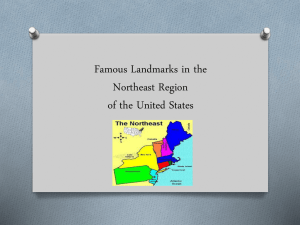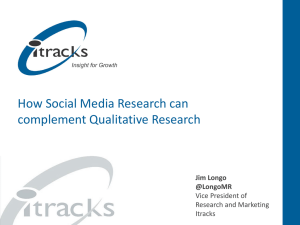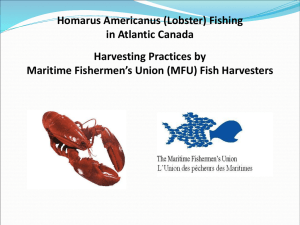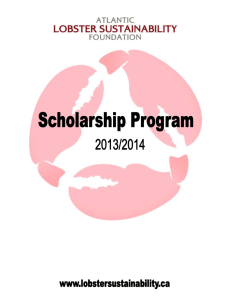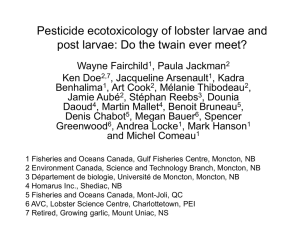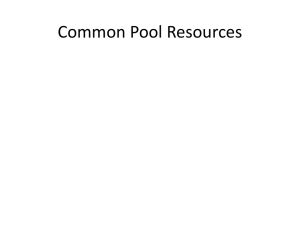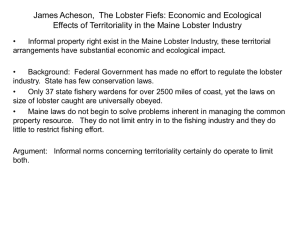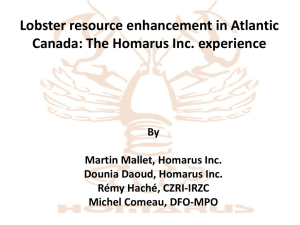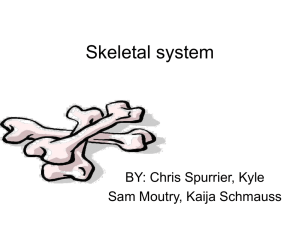Remi Rochette - Atlantic Lobster Sustainability foundation
advertisement
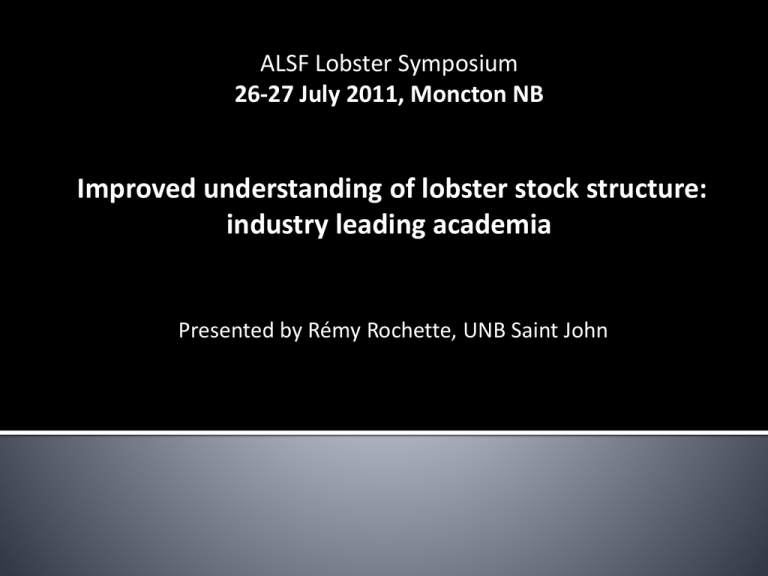
ALSF Lobster Symposium 26-27 July 2011, Moncton NB Improved understanding of lobster stock structure: industry leading academia Presented by Rémy Rochette, UNB Saint John 5-year research initiative End year-1 December 31st, 2011 Large and evolving collaboration Industry ▪ fishermen and fishermen associations throughout Atlantic Canada DFO Science ▪ SABS, BIO, GFC, IML, NLR Academia ▪ UNB SJ, U. Moncton, U. Laval, UPEI, U. Sainte-Anne Natural Sciences and Engineering Research Council of Canada Strategic Project Grant: Age Determination in Crustaceans ▪ Kilada, Rochette, Sainte-Marie, Campana Strategic Project Grant: Lobster settlement and coastal biodiversity ▪ Rochette, Hunt, Dufresne, Pohle Discovery Grant: Lobster ecology ▪ Rochette New Brunswick Innovation Foundation Research Innovation Fund: Age Determination in Crustaceans ▪ Kilada, Rochette Research Innovation Fund: Lobster settlement and coastal biodiversity ▪ Rochette, Hunt Objective: Better define/understand “lobster biological units”, or “lobster stocks”, in Atlantic Canada Outcome of consultation exercise with industry: Better definition/understanding of ”lobster biological units”, or “lobster stocks”, in Atlantic Canada 2007 FRCC report on a sustainability framework for Atlantic lobster Identified this question as one of the major impediments to best management of the resource FRCC: Fisheries Resource Conservation Council management units do not reflect biological stocks…. Overarching objective: Better define/identify lobster stocks, to assist the development of best management practices ▪ Better understand how different areas are inter-connected and inter-dependent ▪ Identify critical brooding (and spawning) grounds ▪ Identify critical recruitment areas ▪ Where to monitor sustainability metrics 2 How does larval dispersal connect lobster stocks and fishing areas? Does the model successfully 3 predict larval settlement? 4 1 How does movement of benthic lobsters contribute to connectivity? Is there spatial variation in egg and larval production? Is there genetic differentiation between lobster stocks? 5 • Quantify the abundance and size of “berried” females in different areas Scientists and students involved: Patrick Ouellet, Bernard Sainte-Marie, John Tremblay, Michel Comeau, Rémy Rochette, Julien Gaudette, Marthe Larsen Haarr • Berried females from NF to BoF • Abundance • Size • Egg development stage (timing of larval release) • Clutch condition • Eggs and larvae (geographic variation?) • Condition (lipids, RNA/DNA) • Larval performance (growth, settlement) • Development of standard protocols, tools and data base >4,500 berried females, and counting... http://biodiversitycollector.com/lobster-project-2011/lobster_index.php Large-scale individual-based bio-physical model to estimate potential connectivity of lobster stocks through larval drift Current model (Chassé & Miller 2010) • expand to include entire range (NEMO-OPA) • improve biological inputs Scientists and students involved: Jöel Chassé, Rémy Rochette, Brady Quinn Does the model successfully predict larval settlement? Determine whether there is significant recruitment on finesediment bottoms Scientists and students involved: John Tremblay, Rémy Rochette, Peter Lawton, Gilles Miron, Gudjon Sigurdsson, Kristin Dinning Elucidate link between larval supply and settlement Identify settlement hotspots Estimate inter-annual and spatial variability in settlement Scientists and students involved: John Tremblay, Rémy Rochette, Peter Lawton, Gilles Miron, Gudjon Sigurdsson, Kristin Dinning GOOD MODERATE LOW 0-0.06 0.3 0.09 1.2 0.05 0.3-0.5 1.0 0-0.06 0 Movement (site fidelity, seasonal migrations) of juvenile and adult lobsters Traditional tagging studies and ultrasonic telemetry Scientists and students involved: Michel Comeau, Rémy Rochette, Peter Lawton, Bryan Morse 1) Real-time position information based on triangulation (RAPT) – 100-200 m study triangle • 25% of time out of shelter (daily average, n=10) • Min: 3.5% (25 mm CL) • Max: 62% (31.3 mm CL) • Significantly more active during nightly high tides 20.3 mm CL 47 mm CL 2) Archived position information based on triangulation (e.g., VR2) 200-300 meters Takes advantage of recent developments in the field of molecular ecology Non-neutral genetic markers ▪ More likely to reveal finer spatial-scale genetic structuring than neutral genetic markers ▪ More likely to reveal adaptation to local conditions Scientists and students involved: Louis Bernatchez, Spencer Greenwood Kenchington et al. 2009 1. Improve our understanding of lobster stock structure and connectivity 2. Identify areas particularly important to sustainability: 1. larval production 2. larval settlement 3. Build the collaboration and its research capability… 1. We have developed a research agenda that will enhance our understanding of lobster stock structure and connectivity 2. Our most important accomplishment to date is arguably the large tri-partite collaborative platform we have developed, as it is essential to the realization of this and future research initiatives spanning the range of the species in Atlantic Canada 3. We have identified inequalities in the ability of industry to participate in the research, and acknowledge these deficiencies need to be addressed 1. We are pursuing additional sources of funding, to deliver on our research agenda and help industry fully participate 2. We have since the spring been elaborating a proposal to ACOA’s AIF for this purpose 3. The AIF project would also involve research on the most appropriate sustainability indices for the industry, and the creation of self-financed system for the ongoing collection and analysis of lobster sustainability data/indices 4. Discussions are on-going with different members of the value chain to refine our proposal Photo Brent Wilson Industry Marc Allain Patty King Kevin Squires Leonard Leblanc Mario Déraspe Ginny Boudreau Eugène O’Leary Ashton Spinney Christian Brun Michelle Thériault Maria Recchia Peter Connors Ronnie Heighton Industry David Decker Darryl MacIver Martin Mallet Klaus Sonnenberg Keith Paugh Gordon MacDonald Dounia Daoud Sylvia Rumbolt Jackie Baker Rachel Long Monty Way Laura Ramsey Nellie Baker Norma Richardson One of the largest research initiative on American lobsters to date Academia Rémy Rochette Gilles Miron Louis Bernatchez Spencer Greenwood Jean Lavallée Michelle Theriault Jerry Amirault and more to come… Government Bernard Sainte-Marie John Tremblay Joël Chassé Patrick Ouellet Michel Comeau Louise Gendron Robert MacMillan Peter Lawton Julien Gaudette Rob Stephenson 17 industry organisations 5 universities 5 government research facilities

